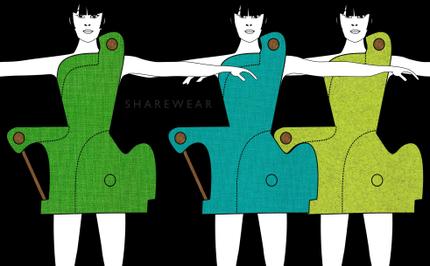Report of Test_Lab: Topology at V2_ in Rotterdam, 17 April 2008, by Marije van Eck.
Drawing parallels with the seminar on mapping at the Piet Zwart Institute, V2_ focused on the term topology in their latest edition of Test_Lab. V2_ Institute for the Unstable Media, is located just off the Witte de Withstraat, the center of creative ideas and artistic outlets in Rotterdam, and thus the ideal location for this bimonthly event, which in this edition focused on how the term topology can be applied to various fields of art and research.
Tiziana Terranova had been invited to give a general introduction, in which she focused on the idea of topology in relation to the Internet. She explained that the Internet is not static, but is constantly changing, and is therefore not a metric space. We could even say it exceeds the three dimensions, caused by action, change of direction and transformation. The Internet is often presented as a frozen image of connected dots, but even those imply there is some underlying movement, captured in the image.
These theories she then applied to the blogosphere. Represented as a topological network model, you can see that there are many blogs which report a certain issue. Over time a process of singularity occurs, and some of these blogs will disappear, while others gain more importance: superhubs appear. Terranova added that it is this she finds intriguing: to create or research network models and to stretch them, bend them, try to throw them off balance, to see if this process of singularity will always occur.
Leaving the formal lecture setting behind, all visitors moved to the next presentation in another corner of the building, making themselves comfortable on one of the many beanbags casually scattered. Christoph Wachter and Mathias Jud presented Zone Interdite, after which they asked the audience to participate and especially contribute to finding Dutch information, so to give people a more complete view of what is happening in photoshopped areas in the world today. The project makes use of world maps and a wiki-model for contributing content, with all content connected to each other, and is therefore another good example of the use of topology.
Imagine walking around a quiet park while hearing the sounds made by small creatures around the pond, and in your headphones the sound of satellites moving thousands of miles above you. Impossible? Yolande Harris, a composer who holds a residency at the Netherlands Media Art Institute, assigned sounds to satellite coordinates, hooked them up to a PDA with GPS and headphones, and the result: the sound of moving satellites, music even. She was fascinated by the old fashioned celestial sea navigation, which is very complex and she was amazed at the blind trust we put in our TomTom to tell us exactly where we are without thinking about how this instrument has measured this. By making something invisible, visible, Harris hopes the project will change the perception of the space we inhabit and she encouraged visitors to take the headphones out into the streets and experience it themselves.
Bureau d’Etudes was also present, and this time they inflicted a real experiment upon the audience, that seemed to have no clear beginning or end. Being given a few pencils, post-its and a very complex “Complex of the Self” map, they tried to make us aware of the many roles we play or have in life, by making us decide ‘how many we are’ and to point out our center of this map. This reminded me of the paper ‘decision trees’ we used to get in biology class to decide the object in front of us was an oak leaf or chestnut leaf. Bureau d’Etudes emphasized that on the map, the center did not necessarily have to be the center. This was a good point to consider in relation to ‘traditional’ maps, because I think the center rarely is the center, or rarely should be, in any case.

Sharewear logo, by Di Mainstone.
The final project presented in Test_Lab was the “Sharewear” dress, developed by the very enthusiastic fashion designer Di Mainstone, who holds a residency at V2_. She designed a bright-colored dress, consisting of several (inter)changeable elements, such as a ‘hovering hat’ with a light to create a halo or a handy torch light, a coffee table, and several other electronic gadgets that emphasize “human exchange, social distance and networked behaviours”, which, hooked up to the dress or to other dresses will interact with each other.
Test_Lab examined the term topology in the broadest sense possible, which was interesting and enlightening and showed that fields of research and art that seem to be very different from each other can always find a way to connect the dots.

